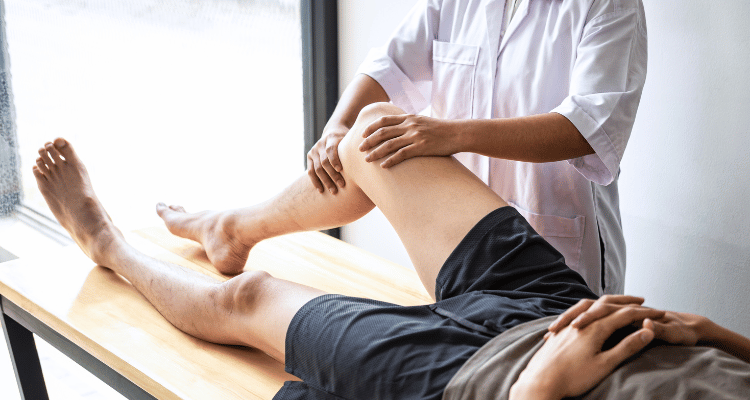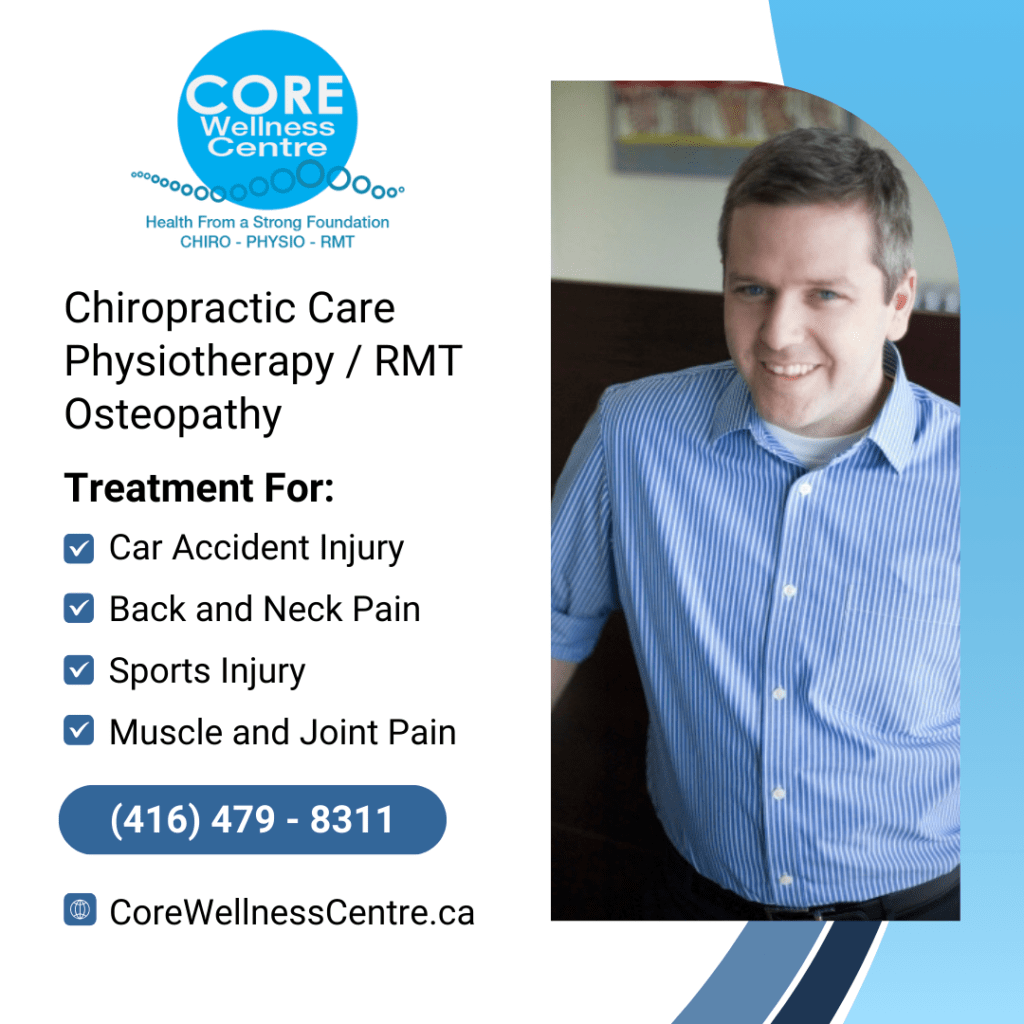
A sports injury can derail your plans in an instant… one day you’re training, the next you’re juggling pain, stiffness, and the worry you’re losing progress.
This guide keeps things simple and practical for exercise after injury: what to do right away, how to rebuild strength, when to ease back into your sport, smarter ways to manage pain, and how to stop the same injury from coming back.
If you want extra support along the way, Core Wellness Centre, Toronto Clinic is here to help you return to your routine safely and with confidence.
At Core Wellness Centre, our specialized team has guided hundreds of athletes and individuals through successful comebacks from injury
Start Your Recovery Journey Today
CALL us on (416) 479 – 8311 or simply book online below
The Reality of Sports Injuries
Whether you’re a weekend warrior or a dedicated athlete, injuries happen. A twisted ankle during your morning run, a pulled hamstring in weekend soccer, or shoulder strain from too many overhead movements…these setbacks can feel devastating when you’re used to being active.
The good news? With the right approach, exercise after injury doesn’t just mean getting back to where you were; it’s an opportunity to build a more resilient, well-rounded fitness foundation.
Phase 1: Immediate Response and Early Recovery
Listen to Your Body (And Healthcare Professionals)
The first 48-72 hours after an injury are crucial. Your immediate priority should be proper medical evaluation, especially for injuries involving joints, persistent pain, or any loss of function.
Don’t skip this step, what seems like a minor tweak might need professional attention to heal properly.
During this initial phase:
- Follow the RICE protocol (Rest, Ice, Compression, Elevation) for acute injuries
- Follow recommended procedures
- Document your pain levels and symptoms
- Resist the urge to “test” the injury with movement
Mental Preparation is Physical Preparation
The psychological impact of injury is often underestimated. Anxiety about re-injury, frustration with limitations, and fear of losing fitness gains are all normal responses. Acknowledging these feelings early and developing coping strategies will serve you well throughout your recovery journey.
Phase 2: Rebuilding Your Foundation
Start with What You Can Do
Once your healthcare professional clears you for gentle movement, focus on what’s working rather than what isn’t. If you have a knee injury, this might mean upper body exercises. A shoulder injury might redirect you toward lower body strengthening and core work.
Key principles for early exercise after injury:
- Pain should not increase during or immediately after exercise
- Start with bodyweight movements before adding external resistance
- Prioritize controlled, slow movements over speed or intensity
- Focus on pain-free range of motion
The Importance of Progressive Loading
Your injured tissue needs gradually increasing stress to heal properly and regain strength. This concept, called progressive loading, is fundamental to safe recovery.
Think of it like building a bridge, you need to test each support before adding the next level.
Week 1-2: Gentle range of motion exercises, basic bodyweight movements
Week 3-4: Light resistance, focusing on form and control
Week 5+: Gradually increase intensity based on pain response and functional improvement
Phase 3: Functional Movement Patterns
Rebuilding Real-World Strength
Once you’ve established pain-free movement, it’s time to train movements that mirror your sport or daily activities. This phase bridges the gap between basic exercises and full activity return.
For runners: Progress from walking to marching in place, then to gentle jogging motions without impact
For athletes: Start with sport-specific movements at slow speeds with perfect form
For general fitness: Focus on compound movements that integrate multiple muscle groups
Don’t Neglect the Uninvured Side
Research shows that training your uninjured limb can actually help maintain strength and neural pathways in the injured side through a phenomenon called cross-education. Continue training what you can while respecting your injury limitations.
Phase 4: Smart Pain Management Strategies
Understanding Different Types of Pain
Not all pain is created equal when it comes to exercise after injury. Learning to distinguish between different pain signals helps you make informed decisions about activity modification.
Acceptable discomfort: Mild muscle fatigue, slight stiffness that improves with gentle movement
Warning signs: Sharp, shooting pain; pain that persists or worsens after activity; swelling that returns
Natural Pain Management Tools
Beyond medication, several strategies can help manage discomfort during your comeback:
- Heat therapy before exercise to improve tissue flexibility
- Cold therapy after exercise to manage inflammation
- Gentle stretching and mobility work
- Proper sleep and nutrition to support healing
- Stress management techniques like deep breathing or meditation
Phase 5: Return to Sport and Activity
The 10% Rule
When returning to your previous activity levels, increase volume, intensity, or duration by no more than 10% each week. This conservative approach gives your tissues time to adapt and significantly reduces re-injury risk.
Testing Your Limits Safely
Before declaring yourself fully recovered, test your limits in controlled environments:
- Practice sport-specific movements at game speed
- Challenge your injured area with functional tests
- Gradually increase training intensity while monitoring pain response
- Consider working with a coach or trainer familiar with injury recovery
Preventing Future Injuries
Address the Root Cause
Many injuries result from underlying imbalances, poor movement patterns, or training errors. Use your recovery period as an opportunity to identify and address these factors:
- Strength imbalances between opposing muscle groups
- Poor flexibility or mobility in key areas
- Training errors like doing too much too soon
- Equipment issues or environmental factors
Build a More Resilient Body
Your comeback strategy should leave you more injury-resistant than before:
- Include unilateral (single-limb) exercises to address imbalances
- Incorporate balance and proprioception training
- Vary your training to avoid repetitive stress
- Prioritize recovery with adequate sleep and nutrition
When to Seek Professional Help

Consider working with us at Core Wellness Centre if you experience:
- Pain that doesn’t improve with rest and basic self-care
- Recurring injuries in the same area
- Significant anxiety about returning to activity
- Complex injuries involving multiple structures
- Performance that doesn’t return to previous levels
Your Comeback Story Starts Today
Exercise after injury isn’t just about getting back…it’s about getting back better. Every setback is an opportunity to build greater awareness of your body, develop new movement skills, and create a more balanced approach to fitness.
Remember that recovery isn’t always linear. You’ll have good days and challenging days, but consistency with smart progression will get you there. Trust the process, listen to your body, and celebrate small victories along the way.
How Core Wellness Centre Helps Your Comeback
Chiropractic Care
- Focus: Restoring comfortable joint motion, easing nerve and muscle irritation, and improving overall movement quality so you feel confident moving again.
- What this looks like: Thorough assessment; spinal and peripheral joint mobilization/manipulation when appropriate; soft-tissue techniques; mobility work; and simple, progressive home exercises. We also coach pacing, how to increase walking, cycling, or gym sessions without provoking symptoms.
- How it supports your return: Helps you move with less stiffness and more control, pairs nicely with step-by-step activity progressions, and addresses contributing factors so the same problem is less likely to return.
Physiotherapy
- Focus: Building a progressive, individualized plan that retrains strength, balance, and endurance—without triggering pain.
- What this looks like: Graded exercise therapy, balance and core training, gait and movement coaching, load management, and return-to-activity planning (walk/run programs, gym modifications, class-by-class progressions).
- How it supports your return: Maps out how to go slow (step 1), reintroduce walking/swimming (step 2), monitor symptoms (step 3), and develop the balance and core control you need (step 4). Your physio will also advise on recovery windows and hydration/nutrition basics aligned with step 5.
Osteopathy
- Focus: Gentle, hands-on techniques to improve tissue mobility, circulation, and overall alignment patterns that influence how you move and feel.
- What this looks like: Myofascial and soft-tissue work, joint techniques, breathing and rib mechanics, and strategies to reduce protective muscle guarding so exercise feels smoother and safer.
- How it supports your return: Eases restrictions that can slow progress, complements physiotherapy exercises, and helps your body tolerate gradual activity increases without flaring up.
RMT Massage
- Focus: Reducing muscle tension, easing pain, and improving circulation, especially helpful in the sub-acute and recovery phases.
- What this looks like: Therapeutic massage, trigger-point work, gentle techniques for sensitive areas, and home-care guidance (self-massage, heat/cold).
- How it supports your return: Helps you feel more comfortable between sessions, supports better movement quality, and pairs well with your graded exercise plan.
Ready to start your safe comeback journey?
Don’t navigate injury recovery alone
CALL us on (416) 479 – 8311 TODAY
or simply book online below
We offer Direct Billing, WSIB, MVA and Facilitate Claims
Professional Support for Your Journey

If you want expert guidance through your recovery journey, Core Wellness Centre is here to help you return to your routine safely and with confidence.
Our multi-discipline team understands that every injury and every person is unique, and we’re committed to developing personalized strategies that get you back to what you love doing.
Your injury doesn’t define you – your comeback will.
Take the first step today and CALL (416 479 – 8311), and remember that every small movement forward is progress worth celebrating.

